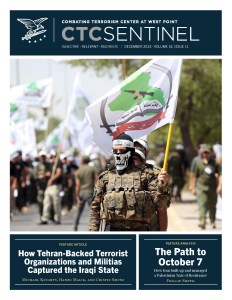From the Editor
In the December feature article, Michael Knights, Hamdi Malik, and Crispin Smith outline how over the past two years Tehran-backed terrorist organizations and militias captured the Iraqi state, a development that could have dramatic implications for the regional terrorist threat, regional stability, U.S. interests, and great power competition in the wake of Iran enabling the second deadliest terrorist attack in history on October 7.
They write that “Iran-backed terrorists and militias lost the 2021 elections in Iraq yet ended up picking the prime minister anyway and taking charge of the world’s fifth-largest oil producer. This remarkable reversal of fortunes in 2022 was not delivered via the barrel of a gun but rather a series of cool-headed and coordinated moves by Iran’s Revolutionary Guard, by Iranian-groomed and militia-controlled judges, and by militia politicians. The country’s oil economy, its freedoms, and its intelligence services are being gutted by militias to ensure their rule is permanent. Yet unprecedented control has not moderated these militias: The Gaza war has shown that these armed factions are also still addicted to militant ‘resistance’ to the United States. The result is the emergence of a terrorist-run state with greater resources than any of Iran’s other proxy networks, hiding behind the façade of a sovereign country.”
The attack on Israel on October 7 and its aftermath have underlined the regional threat posed by the broader Iran threat network. Besides Hamas and Palestinian Islamic Jihad, a multitude of other Tehran-backed Palestinian armed groups participated in the attack, including Fatah splinters and leftist groups. Phillip Smyth examines how Iran built up and managed a constellation of Palestinian ‘Axis of Resistance’ groups from across the ideological spectrum and empowered them to launch an attack that killed 1,200 Israelis. He writes: “Iranian assistance allowed its Palestinian proxies to amass the firepower, messaging know-how, and much of the hi-tech equipment necessary to carry out and propagandize the attack.”
Austin Doctor and Sam Hunter examine the evolving threat of improvised explosives devices in the United States. They write: “Violent extremists continue to innovate, drawing on emerging technologies and creative problem solving. The onus of initiative requires that the counterterrorism mission community looks over the horizon to identify emerging threats.”
Paul Cruickshank, Editor in Chief
 Skip to content
Skip to content

